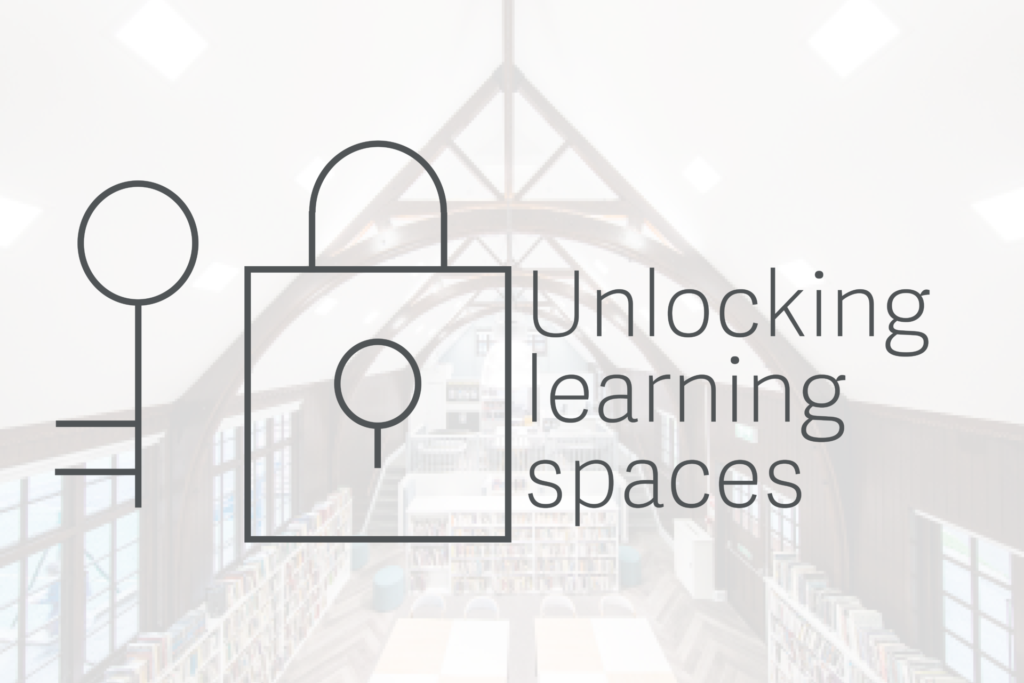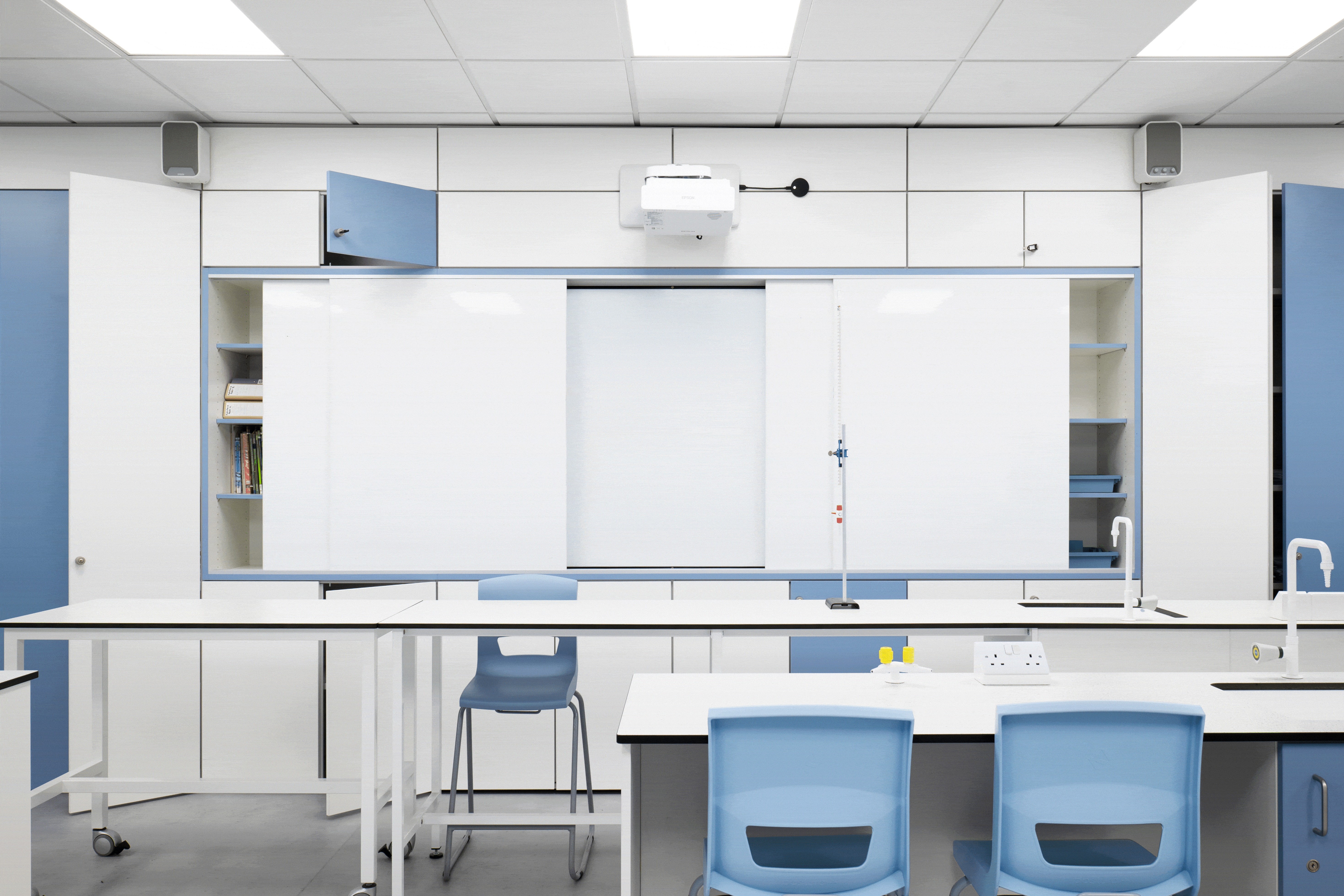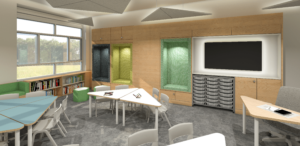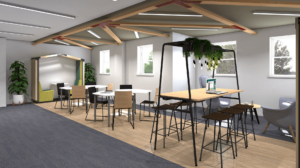Since lockdown began back in March, we realised that the events industry would be the first to suffer amid the global pandemic, and we would sorely miss seeing our esteemed colleagues in the education sector and have those quality conversations that teachers rarely find the time to have in their day to day working lives. As part of our commitment to education, we decided to take our event from the physical to the virtual platform and curate a multitude of subjects that industry experts could dissect, and attendees could debate and digest. It was also a way in which we could convey our thanks to all the hardworking devoted teachers whose unwavering devotion and resilience has been invaluable for parents and children.
In tandem with Noble and Eaton (strategic consultants in transforming schools), we hosted our first webinar 4th December, where we explored how to breathe life into redundant spaces within schools and designing future education spaces beyond the COVID-19 crisis.
Our second session took place on 4 February 2021 titled ‘The future of learning in schools’. Chaired by Dr Adam England, International Principal and Specialist in Literacy and Self Determined Learning, the session had three guests, Mark Anderson, ICT Evangelist, Dr Paul Heery, Academy Trust CEO and Headteacher, and Clare Bowman, an Architect and Sustainability Advisor with a specialist interest in biophilic environments. Each panellist brought different experiences and knowledge to the key question being asked around the topic of what is “The future of learning”?
Mark told us “It’s funny how things you say end up coming to pass. In November ‘18 I delivered a keynote to school leaders at the #EdExMENA and school leaders conference in Dubai. During that presentation, I shared a slide which said ‘The future of education will involve teachers using AI to simplify formative assessment to provide personalised learning opportunities.’
During the pandemic, we have seen schools respond brilliantly to the difficult situation that they have been faced with. Whilst some schools may have found it a bit more difficult in terms of their technological setup, it’s been a superb hallmark of the profession to see the dedication of teachers to the children and communities they serve during the last 12 months.
The way we teach has changed, exams have changed, the disadvantage gap widened. One way that some schools and communities have thrived however is where they have had access to smart systems to supplement and support their curriculum. Using modern AI-driven tools there are many ways that teachers have been supplementing and supporting learning. From some of the simple AI built into our everyday tools such as PowerPoint or more dedicated services such as the superb CENTURY Tech; “a teaching and learning tool that combines artificial intelligence with the latest research in learning science and neuroscience. It creates constantly adapting personalised pathways for every student and powerful intervention data for teachers.” we can see that AI tools really are now in our everyday vernacular.”
As we move forward in time, we are only more likely to see these types of tools that help reduce some of the administrative burden of activities such as marking, to let teachers spend their time doing what they’re best at, teaching and supporting students with their misconceptions. Data is information without context and tools such as CENTURY help give teachers what Dr England described as “wisdom” to help teachers focus on their core business. “Necessity is the mother of invention”, said Plato and we’ve seen that hugely increase in the ways in which technology and education companies have responded to the pandemic and the needs of schools. Is it now the time to really start digging deeper into online assessments for qualifications? For AI to really help power the curriculum with highly personalised learning pathways tailored to everyone’s learning needs, supported and led by expert teachers? It is definitely the case that we are seeing a much more research-informed profession with the application of cognitive psychology and neuroscience being more frequently the norm in conversations about teaching and learning. Will technology of the future be able to work in tandem with teachers to help everyone achieve their potential?
Certainly, Dr England thinks that whatever the future holds, allowing children to have some control over their destiny in how, when and where they learn is an important aspect to consider. A strong supporter of SDL (self-directed learning), Dr England shared, “This isn’t a crisis, it’s an opportunity to rethink our education system and create schools that are both future-proof and COVID-proof”. He went on to share, “Ironically, COVID counter measures are helping to re-energise education by creating meaningful workspaces,” and it certainly has some credence. Dr Paul Heery added this to the debate saying, “Self-direction is the key to unlocking learning” when he was talking about the situation we are experiencing in the pandemic. He shared on the importance of learners learning, “How they apply resilience,metacognitive and softer skills, so we don’t end up with a generation that knows a lot but cannot apply it in the working world”.
Dr England explained, “Self-direction is the key to unlocking learning. For those who like heuristic and problem solving; howdo we set our learners on that voyage of discovery? Once you do it, the curricular content embeds itself at a much deeper level, proceeding a much faster rate. So what does SDL mean? The technical term is heutagogy –self-determined learning. Sage on stage is gone. We as teachers are scaffolding an environment and curriculum for learners to explore that journey of self-discovery, which is not ‘lazy teaching’”. Dr England suggested that Elon Musk is a figurehead for this flexibility. Brainstorming, Helping learners understand how they learn. He went on to say, “Once achieved, you can literally let them loose in an SDL area.” This certainly sounds compelling as the future of education but not every child has a love of learning, surely the evidence would suggest that it isn’t as successful by examination standards? England continued, “How can we as teachers scaffold curriculum and pedagogy? SDL allows the building-in of flexibility to facilitate a journey of self-discovery –flexible learning is a tried and tested system in the UK, Isle of Man, Moscow and Africa as well as supported in New Zealand and Australia. Essentially, by relocating flexibility of learning onto the learner, its lead to an uplift in value-added GCSE’s and A levels consistently betweenplus 1.5 and 1.8 grade above predicted.” Clearly, for Dr England, the priority is the individual’s choice to learn and that includes the choice as to where someone learns.In Heery’s schools, learners have found the transition to home learning easier thans ome others. He put this down to the time they spent building in learning around emotional well being, resilience, metacognition, Heery explained, “…we now need students who are able to make decisions for themselves. If we haven’t given them the skills and the motivation to push forward their own learning, and the understanding of why that’s important then they would have struggled last year…|” –clearly it isn’t “just about access to technology.” We’d be inclined to agree: certainly, positive attitudes tolearning are paramount in the success a student can make.The final guest in the discussion, Architect and Sustainability Advisor, Clare Bowman, brought us back to earth with some compelling research she’d undertaken at Putney High School. ‘The Biophilic Classroom’. Clare is an architect who has a real interest in ‘biophilic design’. Biophilic design is a concept used to increase connectivity to the natural environment through the use of direct nature, indirect nature, and space and place conditions in thedesign of spaces. With that in mind, working with Putney High School, Clare worked on designing a learning space based around this idea of biophilic design. They called it the ‘Futures Hub’. Their research aimed to demonstrate how adding things from nature such as plant life into a space could improve air quality and the learning environment for students and staff. It also revealed that it had a hugely beneficial effect and what was even more interesting was that the more plant life they added the better it was. You can find out more about the ‘Futures Hub’, the research and its application here.Unlocking learning spaces10:50 18 February in Classrooms, Education, Modern ways of learning, News and views, School interior design by Rosanna Remmington
6LikesShare
Our webinar series dedicated to educators.Since lockdown began back in March, we realised that the events industry would be the first to suffer amid the global pandemic, and we would sorely miss seeing our esteemed colleagues in the education sector and have those quality conversations that teachers rarely find the time to have in their day to day working lives. As part of our commitment to education, we decided to take our event from the physical to the virtual platform and curate a multitude of subjects that industry experts could dissect, and attendees could debate and digest. It was also a way in which we could convey our thanks to all the hardworking devoted teachers whose unwavering devotion and resilience has been invaluable for parents and children.In tandem with Noble and Eaton (strategic consultants in transforming schools), we hosted our first webinar 4th December, where we explored how to breathe life into redundant spaces within schools and designing future education spaces beyond the COVID-19 crisis.Our second session took place on 4 February 2021 titled ‘The future of learning in schools’. Chaired by Dr Adam England, International Principal and Specialist in Literacy and Self Determined Learning, the session had three guests, Mark Anderson, ICT Evangelist, Dr Paul Heery, Academy Trust CEO and Headteacher, and Clare Bowman, an Architect and Sustainability Advisor with a specialist interest in biophilic environments. Each panellist brought different experiences and knowledge to the keyquestion being asked around the topic of what is “The future of learning”?Mark told us “It’s funny how things you say end up coming to pass. In November ‘18 I delivered a keynote to school leaders at the #EdExMENA and school leaders conference in Dubai. During that presentation, I shared a slide which said ‘The future of education will involve teachers using AI to simplify formative assessment to provide personalised learning opportunities.’ During the pandemic, we have seen schools respond brilliantly to the difficult situation that they have been faced with. Whilst some schools may have found it a bit more difficult in terms of their technological setup, it’s been a superb hallmark of the profession to see the dedication of teachers to the children and communities they serve during the last 12 months.The way we teach has changed, exams have changed, the disadvantage gap widened. One way that some schools and communities have thrived however is where they have had access to smart systems to supplement and support their curriculum. Using modern AI-driven tools there are many ways that teachers have been supplementing and supporting learning. From some of the simple AI built into our everyday tools such as PowerPoint or more dedicated services such as the superb CENTURY Tech; “a teaching and learning tool that combines artificial intelligence with the latest research in learning science and neuroscience.
It creates constantly adapting personalised pathways for every student and powerful intervention data for teachers.” we can see that AI tools really are now in our everyday vernacular.”As we move forward in time, we are only more likely to see these types of tools that help reduce some of the administrative burden of activities such as marking, to let teachers spend their time doing what they’re best at, teaching and supporting students with their misconceptions. Data is information without context and tools such as CENTURY help give teachers what Dr England described as “wisdom” to help teachers focus on their core business. “Necessity is the mother of invention”, said Plato and we’ve seen that hugely increase in the ways in which technology and education companies have responded to the pandemic and the needs of schools. Is it now the time to really start digging deeper into online assessments for qualifications? For AI to really help power the curriculum with highly personalised learning pathways tailored to everyone’s learning needs, supported and led by expert teachers? It is definitely the case that we are seeing a much more research-informed profession with the application of cognitive psychology and neuroscience being more frequently the norm in conversations about teaching and learning. Will technology of the future be able to work in tandem with teachers to help everyone achieve their potential?
Certainly, Dr England thinks that whatever the future holds, allowing children to have some control over their destiny in how, when and where they learn is an important aspect to consider. A strong supporter of SDL (self-directed learning), Dr England shared, “This isn’t a crisis, it’s an opportunity to rethink our education system and create schools that are both future-proof and COVID-proof”. He went on to share, “Ironically, COVID counter measures are helping to re-energise education by creating meaningful workspaces,” and it certainly has some credence. Dr Paul Heery added this to the debate saying, “Self-direction is the key to unlocking learning” when he was talking about the situation we are experiencing in the pandemic. He shared on the importance of learners learning, “Howthey apply resilience, metacognitive and softer skills, so we don’t end up with a generation that knows a lot but cannot apply it in the working world”.sixth form centre redesign for independent schoolDr England explained, “Self-direction is the key to unlocking learning. For those who like heuristic and problem solving; how do we set our learners on that voyage of discovery? Once you do it, the curricular content embeds itself at a much deeper level, proceeding a much faster rate. So what does SDL mean? The technical term is heutagogy –self-determined learning. Sage on stage is gone. We as teachers are scaffolding an environment and curriculum for learners to explore that journey of self-discovery, which is not ‘lazy teaching’”. Dr England suggested that Elon Musk is a figurehead for this flexibility. Brainstorming, Helping learners understand how they learn.
He went on to say, “Once achieved, you can literally let them loose in an SDL area.” This certainly sounds compelling as the future of education but not every child has a love of learning, surely the evidence would suggest that it isn’t as successful by examination standards? England continued, “How can we as teachers scaffold curriculum and pedagogy? SDL allows the building-in of flexibilityto facilitate a journey of self-discovery –flexible learning is a tried and tested system in the UK, Isle of Man, Moscow and Africa as well as supported in New Zealand and Australia. Essentially, by relocating flexibility of learning onto the learner, its lead to an uplift in value-added GCSE’s and A levels consistently between plus 1.5 and 1.8 grade above predicted.” Clearly, for Dr England, the priority is the individual’s choice to learn and that includes the choice as to where someone learns.In Heery’s schools, learners have found the transition to home learning easier than some others. He put this down to the time they spent building in learning around emotional well being, resilience, metacognition, Heery explained, “…we now need students who are able to make decisions for themselves. If we haven’t given them the skills and the motivation to push forward their own learning, and the understanding of why that’s important then they would have struggled last year…|” –clearly it isn’t “just about access to technology.” We’d be inclined to agree: certainly, positive attitudes to learning are paramount in the success a student can make.School dining hall designThe final guest in the discussion, Architect and Sustainability Advisor, Clare Bowman, brought us back to earth with some compelling research she’d undertaken at Putney High School. ‘The Biophilic Classroom’.
Clare is an architect who has a real interest in ‘biophilic design’. Biophilic design is a concept used to increase connectivity to the natural environment through the use of direct nature, indirect nature, and space and place conditions in the design of spaces. With that in mind, working with Putney High School, Clare worked on designing a learning space based around this idea of biophilic design. They called it the ‘Futures Hub’. Their research aimed to demonstrate how adding things from nature such as plant life into a space could improve air quality and the learning environment for students and staff. It also revealed that it had a hugely beneficial effect and what was even more interesting was that the more plant life they added the better it was. You can find out more about the ‘Futures Hub’, the research and its application here.
In summary
This was a hugely interesting and compelling session with lots of perspectives shared. On the one hand, we can see there is a real need for schools to consider online as well as physical learning spaces.Where schools need to think carefully about how they blend learning in the future. A mix of the synchronous and asynchronous opportunities that are afforded when you give students more control over their learning such as we heard from the perspectives of Dr England and Dr Heery. With Mark Anderson expressing the enormous opportunity to leverage AI, reduce some of the burdensome and repetitive tasks teachers undertake and free them up to support learners the best way they can as expert teachers alongside working in clean, green and conducive environments for learning are all part of the future of education.
Sign up to the concluding part three of our webinar series ‘Unlocking learning spaces –Flourishing minds & learning environments’ in association with Noble and Eaton-4pm Thursday,18th March.Special guest keynotes include Professor Derek Clements-Croome, renowned as one of the world’s leading experts on wellbeing and sustainability in the workplace and Jonathan Matta, KI’s National Education Leader, supporting organisations in their pursuit of solving complex challenges by applying the power of design.



